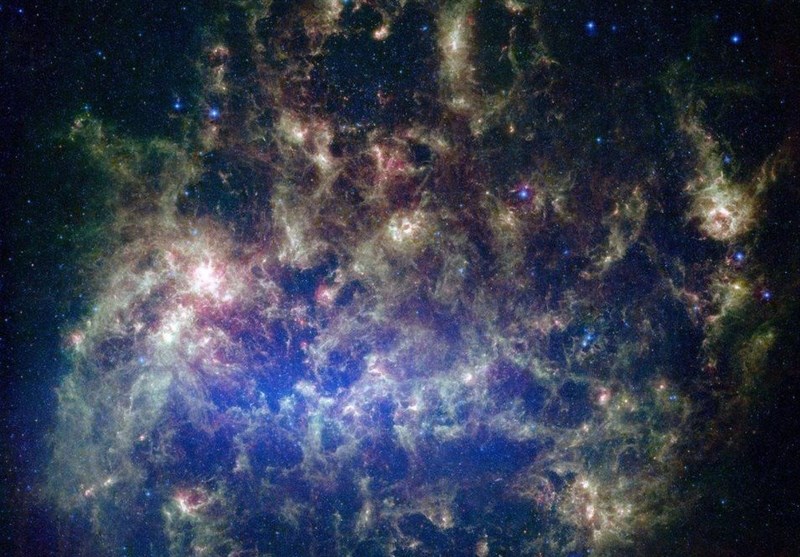Astronomers Map Most Extensive Atlas of Milky Way Galaxy Yet
TEHRAN (Tasnim) – There are nearly 2 billion stars in our galaxy. At least that's what the most current map shows. Astronomers have mapped the most extensive atlas of our Milky Way galaxy yet, including the positions of each and every one of those stars.
The European Space Agency's Gaia space observatory also tracked the movement, colors and brightness of these stars as well as the first visible measurement of the acceleration of our solar system.
The new data confirms that the solar system is accelerating in its orbit around the Milky Way. Over the course of a year, our sun accelerates toward the Milky Way's center by 7 millimeters a second. Overall, the sun's orbit around the Milky Way is about 230 kilometers per second, or 514,495 miles per hour.
This acceleration information will allow astronomers to measure the mass of our galaxy and better understand the origins of our solar system within our galaxy.
This is the third publicly available data release from the space telescope. The data was made available on Thursday.
The so-called "Galaxy Surveyor" telescope helped scientists produce the most accurate three-dimensional map of our galaxy to date.
Gaia is uniquely positioned about 930,000 miles from Earth in the opposite direction from the sun. The spacecraft, launched in 2013, carries two telescopes that can scan our galaxy from a location called the Lagrange 2, or L2, point. At this point, the spacecraft is able to remain in a stable spot due to the balance of gravitational forces between Earth and the sun.
This also means that the spacecraft doesn't have any interference from Earth's light and it can use the minimum amount of fuel to remain in a fixed position.
The vantage point allows Gaia to have unfettered views and continuously scan our galaxy. The observatory can determine the age of the stars it surveys by collecting information about their temperatures and compositions -- a bit like a stellar checkup.
Gaia measures the distances of stars by tracking their movements -- something that is much harder to do on Earth because our atmosphere obscures this tiny stellar movement from the perspective of ground-based telescopes.
Previously, Gaia was able to track the positions of 1.6 billion stars. This latest data release brings the map up to just below 2 billion stars. What's more, the positions have been calculated more accurately.
"Gaia is measuring the distances of hundreds of millions of objects that are many thousands of light years away, at an accuracy equivalent to measuring the thickness of hair at a distance of more than 2000 kilometers," said Floor van Leeuwen, astronomer at the University of Cambridge's Institute of Astronomy and UK Gaia DPAC project manager, in a statement.
"These data are one of the backbones of astrophysics, allowing us to forensically analyze our stellar neighborhood, and tackle crucial questions about the origin and future of our Galaxy."
The new data has particularly accurate measurements for the 300,000 stars located within 326 light-years of our sun. Understanding the positions of these stars now enables astronomers to predict how they will change in the next 1.6 million years.
The information collected by Gaia also allowed astronomers a glimpse at the stars that populate two of the Milky Way's companion galaxies, the Small and Large Magellanic Clouds.
Gaia is currently scheduled to continue collecting star data through 2020, and its mission could be extended until 2025. Ultimately, researchers anticipate that Gaia will be able to provide more accuracy and collect a total catalog of more than 2 billion objects at mission's end.
The mission was designed to add to our knowledge of the Milky Way based on information gathered by the Hipparcos satellite used in the 1980s and 1990s. It mapped 100,000 stars. When Gaia came online and had its first data release in 2016, it increased the number of observable stars in our galaxy times 20.
"For thousands of years, we have been preoccupied with noting and detailing the stars and their precise locations as they expanded humanity's understanding of our cosmos," said Caroline Harper, head of space science at the UK Space Agency, in a statement.
"Gaia has been staring at the heavens for the past seven years, mapping the positions and velocities of stars. Thanks to its telescopes we have in our possession today the most detailed billion-star 3D atlas ever assembled."






